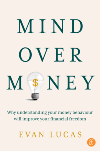Understanding why we do the things we do can help us take better control of our finances. In this edited extract from his book, Mind over Money, Evan Lucas looks at common behavioural biases and how they can affect our financial decisions.
Do you understand why you react the way you do to certain situations? Every action you take comes from somewhere. So where is that? If you can understand where your action has come from – why you reacted the way you did – it gives you the power to take steps to improve the behaviours that are not serving you. You’ll be better for it – especially when it comes to money.
What are behavioural finance biases?
The human brain is designed to make daily decision-making as easy as possible. Life is complex, so biases – learned behaviours and ideas that we can call on to cut to the chase – are something we embrace readily.
Of course, simplifying decisions can lead to errors. Our biases can ‘close off ‘ our minds to better options, experiences and longer-term outcomes. In the world of money and investing this is the opposite of what needs to be done.
Your relationship with money is heavily influenced by your experiences – how you were brought up, how your parents viewed and dealt with money, who you socialise with, where you work, who you work for or with, and your partner’s experiences and views. All these converge to influence and form your money identity. Your money identity then influences your actions. It can lead you to believe a rational decision is an irrational decision and vice versa. Why? Because your biased view makes it so.
The important thing is to recognise your own biases so you can be aware of how your brain is ticking when you’re making decisions.
Common behavioural biases
Let’s run through a few commonly held behavioural biases that relate to money. Get conscious and be honest here – recognising the biases you hold will help focus your mind when it comes to money.
Loss aversion: losing money hurts more than making it
Behavioural scientists have found we experience far more despair when we lose money than we do pleasure when we make a profit. This bias was termed ‘loss aversion’ by Daniel Kahneman and Amos Tversky. It is one of the biggest biases your mind will have to deal with when making money decisions.
Loss aversion has a strong relationship with risk – it means we prefer to avoid financial risk, even if the potential returns are better.
Let’s take a look at one of the tests Kahneman and Tversky used to examine loss aversion in their study. I want you to think about what you would do in this situation – but don’t overthink it. Focus on your initial reaction, because that will be your biases acting for you.
If you were given a choice between receiving a guaranteed $900, or having a 90% chance of gaining $1,000 but a 10% chance of losing it all, what option would you take?
I would stake you would take the $900. Kahneman and Tversky found the same. Most participants would take the $900 that is presented as ‘risk free’. But, when you do the cold, hard maths, the ‘risk’ is the same. That is:
Expected value = ($1,000 × 0.9) + ($0 × 0.1) = $900
Now let’s reverse the choice. If you had a choice between a guaranteed loss of $900 or a 90% chance of losing $1,000 but a 10% chance of not losing anything, what option would you take?
I would stake you would take the risk of losing $1,000 with the small chance of losing nothing. Again, this is exactly what Kahneman and Tversky found as well.
Like the first scenario, the cold hard maths shows that the expected value is a $900 loss.
It’s important to understand that this is your biases influencing you to do what you believe is the right thing. That right thing might not be the ‘rational’ thing, because rational isn’t human.
Loss aversion manifests into all sorts of behaviours and, interestingly enough, non-behaviour. If we take the Kahneman and Tversky study into the real world, a 2020 report from the Australian Securities Exchange (ASX) found more than 36% of Australian adults have never invested. There’s a variety of reasons behind this, but the underlying theme is the fear of losing money on the markets.
You can lose value in all investable assets – shares, exchange traded funds (ETFs), bonds, property and even cash. But over time the returns will counter the losses, and there is an almost infinite number of examples that can testify to this. The question is, how much can your mind cope with loss? That comes down to the risk-reward scale.
When it comes to loss aversion you need to think about loss as a relative factor, rather than the be-all and end-all.
I know that is very hard to read. Even the best in the industry still get caught up by loss-making positions in their portfolios or on their bank balances. But what they do better than the rest is to not let the losses impact their long-term view. They keep sight of the goals they are looking to achieve in the future. In other words, they put the loss into perspective, which reduces its emotional impact.
Heuristic simplification: cutting corners
Behavioural finance and psychologists love a complex buzz term, and there is none better than ‘heuristic simplification’. Heuristics is a blanket term for shortcutting – for example, when people use a ‘rule of thumb’ in decision-making, especially when they are not sure about something, that is using heuristics.
Heuristics can be a hindrance in the world of money and investing, where we need to assess high levels of information quickly or when under stress. This can lead to oversimplification or the misuse of information.
There are four parts to heuristic simplification – anchoring, availability bias, attention bias and confirmation bias – and they can all affect how we think and act around money. Note the four parts are not mutually exclusive – they overlap and can work together or against each other.
Anchoring
In behavioural finance, the term ‘anchoring’ describes your first impression of a financial situation. You tend to stick to that first impression – rightly or wrongly. It becomes your reference point, from which you make all future financial judgements.
Let’s say for instance that you’re in the market for a new car. You find the make and model you’re interested in – it’s priced at $35,000. Armed with this benchmark, you start shopping around and find a dealer who agrees to sell you the same make and model for $33,000 – a $2,000 discount. Your internal ‘anchored’ mind sees this as a win and leads you to ink the deal and hand over the cash.
But have you just shortcut your way out of an even better deal? What if the next dealer offers you the same car for $31,000? What if the better deal was not that car at $35,000 but the car worth $40,000 going for $35,000? Your first impression was that you were being offered a car that was ‘cheap’, and this stopped you from making a more informed decision by doing more market research.
Price anchoring can also impact your investment decision-making. For example, let’s look at a bank stock that is trading at $90 and another bank stock priced at $30. Both banks are well-regarded and have strong earnings. Based on this information, many investors will choose the $30 bank share as it appears to be worth the same as the $90 bank share but is cheaper. They are anchored by price, and by the opinion that the $90 share is ‘expensive’.
However, this isn’t enough information on which to make a sound investment decision.
What I conveniently left out is that the bank with the $30 stock has half the number of customers as the bank with the $90 stock, so it must discount its products to get business. It’s also considered fully valued – meaning there’s little chance of further short-term growth. The bank with the $90 stock, on the other hand, is continuing to innovate, and business is growing well without having to discount. This stock is considered an investment opportunity.
Now, with that information, your opinion should have been swayed. However, research has found that even with this extra information, many people’s initial anchor point, the $90 price, will make them doubt it’s a good investment because it still seems ‘expensive’ compared to the $30 stock.
Availability bias
There can’t be too many of us who haven’t daydreamed about how we’d spend a major lottery win. Common sense tells us the odds are stacked against us. The chance of winning the Powerball lottery is miniscule – you’re looking at odds of one in 134 million. Obviously, that’s not a great marketing point.
Instead, companies that rely on gambling revenue tap into availability bias to encourage us to believe we can be the next winner. In essence, availability bias means our perception of the likelihood of something happening depends on information that comes readily to mind.
It’s a close cousin of recency bias, where we see positive or negative recent events as the most likely long-term outcome. So, if we see a story about someone winning big on lotto, that will alter our perception of the likelihood we will win – despite any evidence of poor odds we may have encountered previously.
Availability bias doesn’t just impact gambling. It also impacts investment decisions. Let’s take the rise of investment options like meme stocks or cryptocurrencies. The information on each is limited. When information is provided, it’s filled with stories of huge windfalls claiming it is the future of finance and money.
What is so concerning about these examples is that a lot of the immediate information is true. People have made fortunes on meme stocks and some people have become millionaires a hundred times over through crypto. However, these people are the exception, not the rule. Meme stocks, crypto and the like are the perfect examples of how our biases, coupled with our personality traits, can lead to detrimental investment behaviours.
‘The quick buck effect’ is just another way of describing availability bias – both want you to believe you can reach your goals well ahead of time.
Attention bias
That quick buck some are attracted to moves us from availability bias to attention bias. Numerous behavioural finance studies have found that individual investors are more likely to buy rather than sell things that catch their attention. This is especially true when these shiny things are mentioned in the media, have abnormal amounts of trading volumes or have an extreme one-day move.
The most glaring example of attention bias in recent history was the GameStop saga. For those who don’t have a social media account, TV or Millennial in the family, let me quickly summarise.
At the beginning of 2021, a group of active Reddit users wanted to target several hedge fund managers they saw as ‘corrupting the system’. Enter US-based retail video game provider GameStop (GME). GME is a run-of-the-mill sort of company listed on the New York Stock Exchange. Several hedge fund managers believed GME was less than a run-of-the-mill company and decided to ‘short’ it – that is, they borrowed GME stocks from unit holders and sold these borrowed units in the market. This meant they were betting that the stock price would go down.
However, an army of Reddit users in a forum called r/WallStreetBets took issue with this and collectively bought GME stocks over and over – so much so that they started to overrun the hedge funds. This pushed the stock price higher and higher, which in turn forced the hedge fund managers to close their short positions and, in the process, lose a fortune.
It instantly became the biggest financial news story in the world. Day after day for six weeks the GameStop saga was leading global news. Initially, it was presented as a David versus Goliath affair, but very quickly the media and markets turned their attention to just how much money some traders and investors were making. This is when attention bias started to become a problem, because the initial reason for the GME trade (beating hedge fund managers at their game) was lost in the narrative, and it became a story about the quick buck.
Let’s bring this back to the work of Daniel Kahneman. Kahneman found that attention bias arises particularly on the buy side of investing because it requires investors to sift through thousands of investment options while being limited by how much information they can process before buying. The sell side of investing doesn’t trigger this problem because investors tend to only sell securities they already own, so there’s less research involved. Kahneman found that the issue with attention-based purchases is that they can lead to disappointing returns or even loss, as the attention event can be a one-off or a false reason to invest in the first place.
That last sentence perfectly summarises what happened with investors who got caught up in the attention GME was getting. Their attention bias overrode the fact that what was happening was an abnormal event and was no basis for buying GME stocks. Instead, the attention on GME was all the information needed for thousands of investors to buy GME at incredible prices.
The GameStop saga eventually dissipated; the media and market moved on. The attention on the stock drifted and suddenly thousands were stuck with hugely inflated stock holdings in a mediocre company. All because their attention bias overrode their reasoning.
Confirmation bias
We come to our final heuristic: confirmation bias. As the name suggests, confirmation bias is the phenomenon of seeking selective information to support your own opinions, or interpreting facts in a way that suits your own world view.
When we hold views on things like politics, health, money or any subject for that matter, we actively seek to confirm what we believe through the opinions of friends, colleagues, experts and others. However, this clouds our view. If we only listen to and engage with certain views and information, this limits our ability to make informed decisions.
The echo chambers of social media have turbocharged confirmation bias. It’s never been so easy to confirm what you believe – just scroll through your social media feeds and you’ll find posts that positively reinforce your choices, beliefs and views. Interact with those posts and the algorithms will suggest other accounts for you to follow that share similar content, reinforcing the echo chamber even further.
Confirmation bias has an added kick in that it plays on the human desire to be right. As a human, you will actively avoid critical opinions, reports or information that goes against your point of view. Instead, confirmation bias means you will actively seek opinions, reports and information that paint your points of view in a positive light.
There are some big financial ideas related to confirmation bias. For example, why haven’t cryptocurrencies overtaken fiat currencies in our everyday lives? Why do we think property is a better investment than most other asset classes even though its long-term returns are lower than some asset peers? Because it’s worked for others, and that is all the confirmation we need.
There are also plenty of beliefs about money that can contribute to confirmation bias. For example, did you grow up believing that investing is gambling, money is the root of all evil or gold is the only reliable form of currency? You will undoubtedly have significant personal bias in the way you respond to these ideas, which in itself should make you sit up and wonder – “Have I allowed my confirmation bias to cloud my thinking about money?”
Anchoring, availability bias, attention bias and confirmation bias are all examples of how our brain’s need to simplify decision-making can really cost us long term. The simple way to counter heuristic simplification is: “don’t judge a book by its cover”. Actively search for differing opinions, views and information. Ask the fundamental question we should all ask ourselves – is this the best option, or do I just think it is?

This is an edited extract from Mind over Money (Major Street Publishing $32.99), republished with permission.
Cover image source: ADragan/Shutterstock.com







Share this article